The AMD Ryzen 3 1300X and Ryzen 3 1200 CPU Review: Zen on a Budget
by Ian Cutress on July 27, 2017 9:30 AM EST- Posted in
- CPUs
- AMD
- Zen
- Ryzen
- Ryzen 3
- Ryzen 3 1300X
- Ryzen 3 1200
Benchmarking Performance: CPU System Tests
Our first set of tests is our general system tests. These set of tests are meant to emulate more about what people usually do on a system, like opening large files or processing small stacks of data. This is a bit different to our office testing, which uses more industry standard benchmarks, and a few of the benchmarks here are relatively new and different.
All of our benchmark results can also be found in our benchmark engine, Bench.
PDF Opening
First up is a self-penned test using a monstrous PDF we once received in advance of attending an event. While the PDF was only a single page, it had so many high-quality layers embedded it was taking north of 15 seconds to open and to gain control on the mid-range notebook I was using at the time. This put it as a great candidate for our 'let's open an obnoxious PDF' test. Here we use Adobe Reader DC, and disable all the update functionality within. The benchmark sets the screen to 1080p, opens the PDF to in fit-to-screen mode, and measures the time from sending the command to open the PDF until it is fully displayed and the user can take control of the software again. The test is repeated ten times, and the average time taken. Results are in milliseconds.
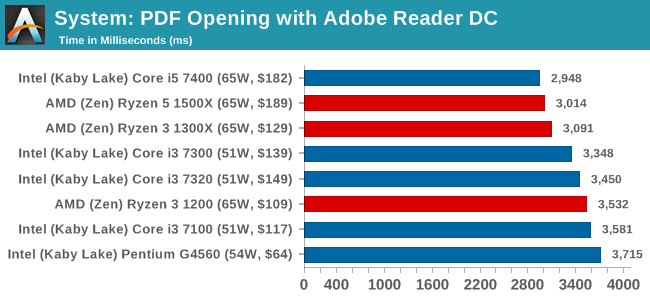
FCAT Processing: link
One of the more interesting workloads that has crossed our desks in recent quarters is FCAT - the tool we use to measure stuttering in gaming due to dropped or runt frames. The FCAT process requires enabling a color-based overlay onto a game, recording the gameplay, and then parsing the video file through the analysis software. The software is mostly single-threaded, however because the video is basically in a raw format, the file size is large and requires moving a lot of data around. For our test, we take a 90-second clip of the Rise of the Tomb Raider benchmark running on a GTX 980 Ti at 1440p, which comes in around 21 GB, and measure the time it takes to process through the visual analysis tool.
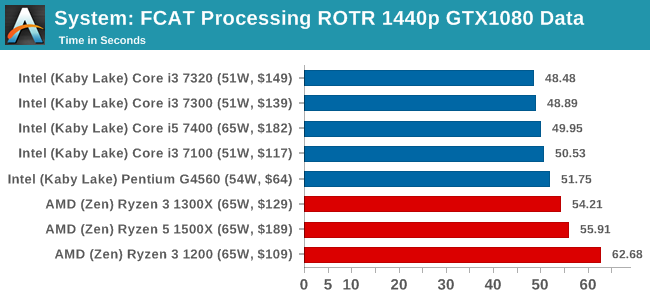
Dolphin Benchmark: link
Many emulators are often bound by single thread CPU performance, and general reports tended to suggest that Haswell provided a significant boost to emulator performance. This benchmark runs a Wii program that ray traces a complex 3D scene inside the Dolphin Wii emulator. Performance on this benchmark is a good proxy of the speed of Dolphin CPU emulation, which is an intensive single core task using most aspects of a CPU. Results are given in minutes, where the Wii itself scores 17.53 minutes.
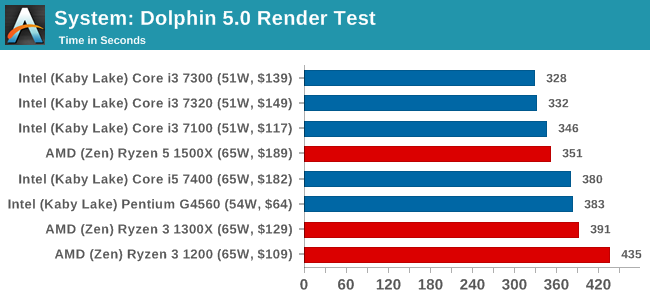
3D Movement Algorithm Test v2.1: link
This is the latest version of the self-penned 3DPM benchmark. The goal of 3DPM is to simulate semi-optimized scientific algorithms taken directly from my doctorate thesis. Version 2.1 improves over 2.0 by passing the main particle structs by reference rather than by value, and decreasing the amount of double->float->double recasts the compiler was adding in. It affords a ~25% speed-up over v2.0, which means new data.
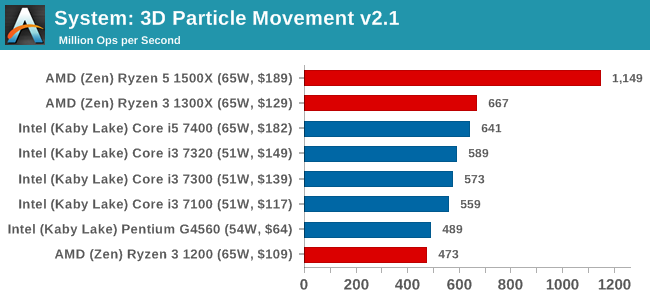
DigiCortex v1.20: link
Despite being a couple of years old, the DigiCortex software is a pet project for the visualization of neuron and synapse activity in the brain. The software comes with a variety of benchmark modes, and we take the small benchmark which runs a 32k neuron/1.8B synapse simulation. The results on the output are given as a fraction of whether the system can simulate in real-time, so anything above a value of one is suitable for real-time work. The benchmark offers a 'no firing synapse' mode, which in essence detects DRAM and bus speed, however we take the firing mode which adds CPU work with every firing.
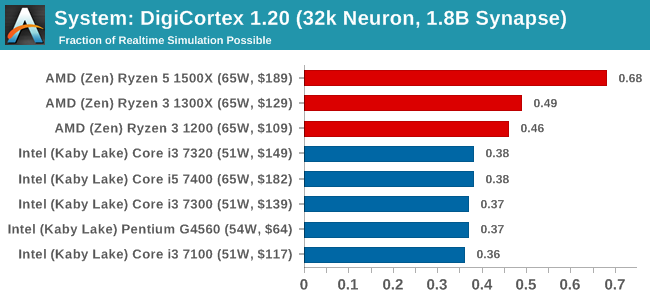
Agisoft Photoscan 1.0: link
Photoscan stays in our benchmark suite from the previous version, however now we are running on Windows 10 so features such as Speed Shift on the latest processors come into play. The concept of Photoscan is translating many 2D images into a 3D model - so the more detailed the images, and the more you have, the better the model. The algorithm has four stages, some single threaded and some multi-threaded, along with some cache/memory dependency in there as well. For some of the more variable threaded workload, features such as Speed Shift and XFR will be able to take advantage of CPU stalls or downtime, giving sizeable speedups on newer microarchitectures.
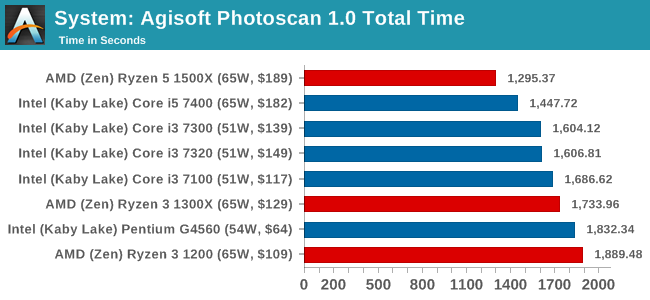










140 Comments
View All Comments
Ian Cutress - Thursday, July 27, 2017 - link
lol yup, just saw it. Should be 889, not 89.T1beriu - Thursday, July 27, 2017 - link
Congrats on getting the review out on day one!Blender 2.78 chart has wrong result number for 1300X.
http://images.anandtech.com/graphs/graph11658/8919...
Ian Cutress - Thursday, July 27, 2017 - link
We always get CPU reviews out on day one... ;)Blender is fixed.
T1beriu - Thursday, July 27, 2017 - link
Another chart that needs a little bit of edit - "Title" at the bottom.http://images.anandtech.com/doci/11658/combined_cp...
jjj - Thursday, July 27, 2017 - link
For value,in the real world mixed or lightly threaded should have more weigh, especially in the lower end where low core count and lower clocks can be a limitation.For power, when comparing diff numbers of cores , the system power is important too- lets say you can have a dual core system at 60W vs a quad at 70W peak. Even if the dual core is more efficient, at the system level the quad wins.
nathanddrews - Thursday, July 27, 2017 - link
Performance is nice and price is good IF you have a dGPU. For entry-level gaming/HTPC builds, that Intel IGP is more valuable than most people think, especially given the amount of media decode/encode power it has. All you need is i3 and you can be watching Netflix 4K or UHD Blu-ray and then switch to playing 1080p 60fps Rocket League. You can do the latter with R3 if you buy a dGPU, but sadly there's no current way to do Netflix or UHD Blu-ray without Intel SGX.MajGenRelativity - Thursday, July 27, 2017 - link
I think that's why AMD also picked this time to release Bristol Ridgemczak - Thursday, July 27, 2017 - link
Yes, imho these cpus are only mildly interesting.In this cpu performance segment, chances are pretty high that a integrated gpu would be good enough. (Sure there's always someone who has a need for high cpu / low gpu, or low cpu / high gpu performance, but I don't think that's the norm.)
So, if a integrated gpu is good enough, with factoring in the cost of an additional gpu amd can't compete on price here. The really interesting competition from AMD in this lower end market has to come from Raven Ridge APUs.
nathanddrews - Thursday, July 27, 2017 - link
In the wise words of Peter Klavin, "Totes McGotes."T1beriu - Thursday, July 27, 2017 - link
Done! Thanks.When should I come back for the full review?